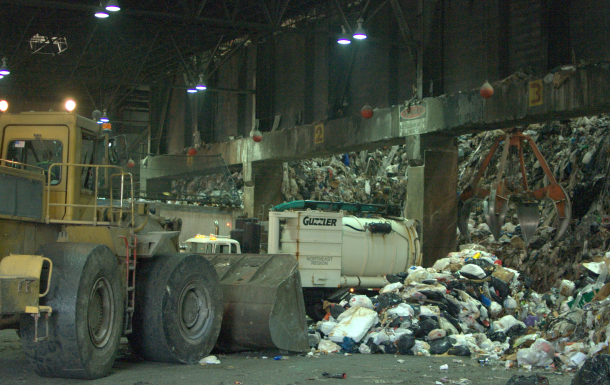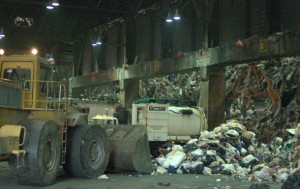There’s a good amount of energy tied up in people’s trash cans. But does it make sense to burn it?
I took a tour of Covanta Energy’s waste-to-energy site here yesterday to delve a little deeper into that question. I learned that modern plants like this one are far less polluting than they used to be and that “reduce, reuse, recycle” is clearly the preferred route. For what’s left over after recyling, though, waste-to-energy plants can fill a role as an alternative to landfills, assuming air quality standards remain in force.

This facility north of Boston takes in about 600,000 tons a year of municipal solid waste from nearby Massachusetts and New Hampshire communities. From that “feedstock,” it generates about 40 megawatts of continuous power, or enough to power about 40,000 homes.
The plant uses the same basic process that fossil fuel plants use: heat from combustion creates steam. That steam is pushed through a turbine to turn a generator which produces electricity. Covanta Energy, one of the largest U.S.-based waste-to-energy developers, has developed a few techniques to reduce air pollutants, making them substantially cleaner than 1980s-era incinerators.
The Covanta plant here is able to get 80 percent to 85 percent below EPA air quality limits and reduce the volume of trash by at least 80 percent, according to facility manager Joe Becker.
“One of the problems we are still fighting is that incinerator word. In the old days, incinerators were just a step up from burning things in your backyard. There was no recovery of energy at all. There was no recovery of pollutants at all,” he said.
There’s a lot of energy potential in garbage: every U.S. citizen produces nearly one ton per year of trash after recycling, leading some researchers to estimate trash could generate enough electricity for 8 million homes. Right now, though, the majority of municipal solid waste is sent to landfills, with about 15 percent incinerated in 2001, according to the EPA.
The number of plants in the U.S. has stalled over public opposition and for economic reasons. But the business model of Covanta Energy, which runs 42 facilities, is profitable: Hauling companies pay them to dispose of the trash and then they sell the power from the plant into the grid.
How clean?
In some states, trash-to-energy plants qualify as renewable energy by law and some proponents say the U.S. should build more, as Europe already has. Municipal solid waste is considered renewable because people continue to generate trash which can’t be recycled.
But as states look to meet renewable-energy mandates through waste, some environmental groups are pushing back. Last week, the Environmental Integrity Project issued a report arguing against more waste-to-energy plants in Maryland, saying they are polluting and resources would be better spent on recycling. Similarly, a waste-to-energy proposal in New York was opposed by some environmental groups which said that efforts to boost recycling would be more beneficial.
According to the EPA, burning municipal solid waste has on average higher nitrogen and sulfur oxide emissions than natural gas, but lower than coal. The carbon from wood and other natural material in trash is considered part of the carbon cycle, whereas fossil fuels aren’t.
At the Covanta plant here, which Becker said is cleaner than most, there are a number of air quality controls. The most important is to have efficient combustion of the boiler which operates as high as 2,000 degrees Fahrenheit. During burning, the trash is sprayed with ammonia and the air is recirculated in the boiler, two techniques to reduce formation of nitrogen oxides, he explained.
After combustion, the flue gas is sprayed with carbon to separate mercury and then a slurry of lime and water to neutralized sulfur oxides, he said. Before going up the smokestack, the flue gas is passed through a series of 20-foot-by-6-foot bags to collect particulates.
The remaining ash is landfilled on site. Recyclable metals, including iron and aluminum, are also collected automatically.
Air quality controls
Many communities already have active recycling programs and some cities are going even further to compost organic material, including yard waste and food scraps. San Francisco, for example, has a target of being “zero waste” by 2020 with aggressive recycling and composting.
In many communities, though, decisions regarding waste-to-energy plants are usually pitted against sending trash to landfills. Landfills give off methane, which is a powerful heat-trapping greenhouse gas, and can cause other environmental problems if there is leaching.
In some European countries, waste-to-energy has more support because air quality controls, which add costs, have been shown to work, Anders Damgaard, a post-doctoral fellow at North Carolina State University told the “Why Files.” Also, Europe is more enthusiastic about waste-to-energy because it has less space available for landfills.
“I think they don’t use air pollution as the main problem because it’s under control now. In Europe, especially in the countries that burn waste, there is really no movement against waste-to-energy. The green organizations see it as viable, they know the alternative is burning more fossil fuel, which is just as polluting if not more so,” Damgaard said.
There is some emerging technology, notably waste gasification, which could improve the environmental performance of waste to energy. Gasification, where material is heated up in an oxygen-starved chamber, allows for more control of emissions compared to combustion.
The process produces a synthetic gas made mostly of hydrogen and carbon monoxide which can be burned to make electricity or converted into chemicals and fuels. Edmonton, Alberta, for example, plans to open a gasification plant to convert its municipal solid waste into ethanol.
After a morning hearing about current waste-to-energy technology here, I felt that burning trash to make electricity is an approach which has merit when compared to landfills but is certainly not a reason to slow recycling rates.
More than anything, though, I walked away from my tour realizing how important the air quality standards set up by the Clean Air Act are today. Covanta Energy’s plant is a clear case where the development of environmental technology is driven by air quality mandates.
Source: cnet

 Follow
Follow